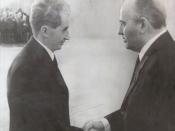On taking office in 1985 Mikhail Gorbachev inherited a Soviet economy with a sagging rate of industrial and agricultural output which was in desperate need of reform. Gorbachev chose to adjust the old system with a period of perestroika. Perestoika translated literally means restructuring and was the term attached to the attempts (1985-91) by the Prime Minister to transform the stagnant, inefficient command economy of the Soviet Union into a decentralized market-oriented economy. However, it was this program of economic, political, and social restructuring that became the unintended catalyst for dismantling what had taken nearly three-quarters of a century to erect: the Marxist-Leninist-Stalinist totalitarian state.
Initially, Gorbachev had no notion of introducing a market economy. The first phase of perestroika simply entailed restructuring the centrally planned economy. Gorbachev had realised that Russia was falling further and further behind the west technologically. He decided to invest heavily in the machine-building industry in order to stimulate technological progress.
While investing considerably more, however, it was expected that living standards would rise due to the fact that there would be more funds available for consumption - a contradiction in terms. It also attempted to devolve more responsibility to the management of the individual enterprises to make decisions for themselves. This, however, was largely unsuccessful as the enterprises, used to being told what to do, were almost unable to think independently as it was an alien concept to them. Furthermore, the first stages of perestroika failed to deal with two major economical issues - prices and ownership - hence little progress was made.
Gorbachev soon realised that his 'restructuring' was failing. He blamed this on the resistance of the upper-level ideological and economic structures. His reaction was an attempt to instigate reform from the bottom upwards. This led to the introduction of Glasnost meaning...


